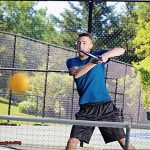Pickleball, the beloved sport that blends the best of tennis, badminton, and ping pong, has been gaining a devoted following in recent years. And while most players are familiar with the classic one-handed backhand shot, there’s another technique that’s been causing quite a stir on the courts: the two-handed backhand.
The two-handed backhand is no longer exclusive to tennis players. It has now become an essential part of many skilled pickleball players’ repertoire. But what exactly is this shot, and how does it differ from its one-handed counterpart? Join me as we dive into the world of pickleball and uncover the existence and advantages of the two-handed backhand.
Whether you’re a novice or a seasoned pro, this blog post will equip you with all the knowledge you need about this unique technique. So grab your paddle and prepare to take your pickleball game to new heights with the dynamic and versatile two-handed backhand. Let’s get started.
Table of Contents
- 1 Table of context
- 2 Understanding the basics: two-handed pickleball backhand
- 3 Two-handed backhand mechanics: grip, swing, and more
- 4 How to hit a consistent and accurate two-handed backhand in pickleball
- 5 Drills and exercises to improve your two-handed backhand
- 6 3 common mistakes to avoid with a two-handed backhand in pickleball
- 7 Conclusion
Table of context
As a connoisseur of racket sports, you understand the importance of mastering various shots to excel on the court. However, there’s one shot that often gets overlooked but can significantly impact your gameplay: the backhand shot. In this article, we’ll delve into the intricacies of the backhand shot and how understanding its context can elevate your pickleball game.
The power of context
Context refers to the background information that shapes our perceptions and influences our decisions. In storytelling, context plays a crucial role in creating a deeper understanding of a story and its characters. It can change the meaning of a narrative and evoke emotional connections.
Similarly, in pickleball, context plays a vital role in directing your attention and emotional attachment to the game. It involves understanding past events and character backstories, which are essential for maintaining narrative continuity and incorporating meaningful context.
Why Backhand Shots Matter in Pickleball
Pickleball has been gaining traction, making it crucial to grasp the significance of backhand shots in this sport. The backhand shot involves striking the ball with your non-dominant hand on the opposite side of your body. Neglecting this shot can limit your ability to execute a wide range of shots effectively, ultimately hindering your overall gameplay.
Exploring the Types of Backhand Shots
- There are two options for executing a backhand shot: a one-handed or two-handed grip. The choice depends on personal preference, physical capabilities, playing style, and familiarity with other racquet sports. Let’s take a closer look at both types:
- One-Handed Backhand: This requires finesse and precision, with three primary grip options: Eastern, Continental, and Semi-Western. Your stance greatly influences balance and reach during gameplay; open or closed stances are recommended options.
The swing motion is crucial for an effective one-handed pickleball backhand, focusing on smoothness, control, weight transfer, and contact with the center of the paddle face. The one-handed backhand offers greater reach and flexibility for defensive plays or powerful shots like drives and smashes.
- Two-Handed Backhand: This grip offers enhanced stability and control by holding the paddle handle with both hands close together. A neutral or slightly open stance is recommended for optimal stability during the coordinated swing motion between both arms, which generates maximum power behind each shot.
Understanding the basics: two-handed pickleball backhand
In the world of pickleball, perfecting the backhand shot can greatly enhance a player’s game. While the one-handed backhand may be more commonly used, incorporating a two-handed backhand can bring its own unique advantages. Let’s delve into these benefits and explore why this technique is worth considering.
Increased Power: A Game-Changer
When it comes to power, the two-handed backhand reigns supreme. By utilizing both hands on the paddle, players can generate a greater force behind their shot. This is especially useful when returning a hard-hitting shot or aiming for a winner from a defensive position. The added power also allows for deep and precise shots, putting pressure on opponents and forcing them to make mistakes.
Improved Control: The Key to Precision
Another perk of the two-handed backhand is its improved control over the ball. With both hands on the paddle, players have more stability and control over their swing, resulting in better placement and accuracy. This comes in handy when trying to hit a precise shot to a specific area of the court or executing a drop shot.
Easier Learning Curve: A Supportive Technique
For those struggling with the one-handed backhand, incorporating the two-handed technique into their game can make learning and mastering the shot easier. The additional support from the second hand makes it easier to control the paddle and adjust your grip, leading to more consistent and effective shots.
Versatility: A Game-Changer
By mastering both types of backhands, players become more versatile on the court. Being able to seamlessly switch between a one-handed and two-handed backhand depending on the situation allows for adaptation to different shots and opponents’ playing styles. This versatility gives players an edge over their opponents and makes them well-rounded players.
In conclusion, while the one-handed backhand may be the go-to shot in pickleball, incorporating the two-handed backhand can bring its own unique benefits. From increased power and control to easier learning and versatility, this technique can take your game to the next level. So why not give it a try and see how it elevates your performance on the court?
Two-handed backhand mechanics: grip, swing, and more
The mechanics behind the two-handed backhand in pickleball are crucial to mastering this powerful and versatile shot. To achieve optimal performance, it is important to adjust your grip accordingly. In this blog post, we will delve into helpful tips for adjusting your grip for a two-handed backhand in pickleball.
Switching your grip during a game may seem intimidating, but with practice, it will become instinctual. Training your muscle memory is essential to making grip changes an unconscious action. This will allow you to execute the two-handed backhand smoothly and efficiently during gameplay.
When it comes to grip placement, many beginners make the mistake of overlapping their hands on the paddle. However, this can hinder the execution of other shots and limit versatility on the court. A better approach is to have your hands touch without overlapping. This provides more control over the paddle and makes it easier to switch between grips.
The dominant hand should be placed on the bottom of the paddle, preferably in a continental grip. This grip offers a stable base for shots and allows for seamless transitions to other grips when needed. It also gives better control over the angle of shots, making precision shots easier to achieve.
For maximum power and control on a two-handed backhand topspin drive, using an Eastern forehand grip with the top hand is recommended. This allows for a full range of motion and generates more power behind the shot. It also aids in creating topspin, which is essential for deep shots or hitting over your opponent’s head.
In conclusion, mastering the two-handed backhand in pickleball requires understanding grip placement and mechanics. With proper training and practice, switching your grip for this shot will become second nature, giving you an edge on the court. Remember to keep your hands touching but not overlapping; use a continental grip for your dominant hand and an Eastern forehand grip for your top hand when hitting a topspin drive.
How to hit a consistent and accurate two-handed backhand in pickleball
Pickleball has taken the sports world by storm with its fast-paced and dynamic gameplay. While mastering the forehand is crucial, having a strong backhand can give you an edge on the court. In this blog post, we will delve into the intricacies of the two-handed backhand and explore how AI-generated content can help you improve your perplexity and burstiness levels for a more impressive and diverse shot.
The Significance of a Strong Two-Handed Backhand
Before we delve into tips for achieving a consistent and accurate two-handed backhand, let’s first understand why this shot is essential in pickleball. Beyond providing power, control, and versatility on the court, it also allows players to maintain their position and cover more ground during intense rallies. Neglecting this shot can limit your ability to execute a variety of shots effectively, giving your opponent an advantage.
Tips for Enhancing Your Two-Handed Backhand
Master Your Grip
The foundation of a powerful, two-handed backhand lies in having the right grip. To achieve this, place your dominant hand on the bottom of the paddle handle and your non-dominant hand above it with your pointer finger extended. Ensure that both wrists are firm yet relaxed for optimal control.
Pay attention to the form.
Proper form is crucial for hitting a consistent and accurate two-handed backhand. Keep your knees bent and your shoulders low for stability and power. As you swing, bring the paddle over your dominant shoulder and point your elbow to the side for a smooth follow-through.
Incorporate Drills
To improve your technique and muscle memory, incorporate drills into your practice routine. These drills can help you perfect your swing motion and footwork, leading to more consistency and accuracy in your shots.
Avoid common mistakes.
Rushing through repetitions or using poor technique are common mistakes that can hinder your progress in mastering the two-handed backhand. Take your time and focus on each step, ensuring proper form and grip, to achieve optimal results.
The Benefits of a Two-Handed Backhand
While both one-handed and two-handed backhands have their advantages, the latter offers improved stability and control. With a double-handed grip, you can generate maximum power behind each shot with a coordinated swing motion between both arms.
Drills and exercises to improve your two-handed backhand
As any pickleball player knows, the two-handed backhand is a shot that can make or break a game. It requires precision, consistency, and proper form to fully unleash its potential on the court. That’s why it’s essential to incorporate drills and exercises into your training regimen to improve this crucial shot. Let’s dive into some recommended techniques that can take your two-handed backhand to the next level.
First and foremost, regular practice is key. Whether it’s shadowing the shot, doing wall rallies with a partner, or incorporating it into your practice sessions and games, consistent repetition is essential for developing muscle memory and improving consistency. As the saying goes, practice makes perfect.
Drills are also an excellent way to enhance the consistency and accuracy of your two-handed backhand. One highly recommended drill is the cross-court drill, where you stand on the baseline and have a partner feed you balls diagonally across the court. The goal is to keep your shots consistent and accurate, building up your control and stability with this shot.
Another drill worth trying is the drop-shot drill. In this exercise, your partner stands at the net while you remain at the baseline. Your partner will drop balls over the net, and you must hit them back using your two-handed backhand. This drill focuses on developing touch and control with this shot, which can be challenging but highly rewarding.
For those looking to work on their footwork, timing, and control with their two-handed backhand, try the lobs and overheads drill. Similar to the drop-shot drill, your partner stands at the net while you stand at the baseline. However, this time they will hit lobs or overhead shots towards you, forcing you to respond with your two-handed backhand. This exercise is perfect for players looking to add more variety to their shots and keep their opponents guessing.
Of course, no matter how much you practice or drill, proper technique is key. The recommended grip for a two-handed backhand in pickleball is the continental grip, with your dominant hand on the bottom and your non-dominant hand above it. This grip provides better control and power on your shots. As for technique, focus on turning your body quickly, staying compact, and keeping your paddle face closed to create topspin as you swing low to high.
Lastly, don’t be afraid to incorporate variations into your two-handed backhand shots.
3 common mistakes to avoid with a two-handed backhand in pickleball
The two-handed backhand in the game of pickleball is a powerful and versatile shot that can give players an advantage on the court. However, mastering this shot requires proper form and technique, and many players make common mistakes that can hinder their performance.
As an expert on the subject, I have observed these mistakes firsthand and am here to share the top three that players should avoid when using a two-handed backhand in pickleball.
Neglecting to Keep Shoulders Low
One of the most prevalent mistakes made by players when executing a two-handed backhand is not keeping their shoulders low. This can result in reduced power and control on the shot, as well as increasing the risk of injury.
To avoid this error, it is essential to focus on bending at the knees instead of the back, keeping your shoulders low and relaxed. By doing so, you can generate more power and maintain better control over your shot.
Not Bending at the Knees
Similar to not keeping your shoulders low, not bending at the knees can also impede your two-handed backhand. Bending at the knees provides stability and creates a strong foundation for executing the shot. When players fail to bend at the knees, they rely too much on their arms instead of utilizing their legs, resulting in reduced power and control. It is crucial to concentrate on bending at the knees and engaging your leg muscles when performing a two-handed backhand.
Inadequate Follow-Through
Follow-through is a crucial aspect of maintaining control and power on a two-handed backhand shot. Many players make the mistake of not fully extending their arms and following through with their shot.
This can lead to a weaker shot with decreased accuracy. To avoid this error, make sure to bring your paddle up and over your dominant shoulder after making contact with the ball. This will add power and control to your shot, making it more challenging for your opponent to return.
Conclusion
In conclusion, the two-handed backhand has revolutionized the game of pickleball.
Its unmatched power, precision, and adaptability have made it a crucial shot for players striving to excel on the court. By delving into its mechanics and understanding its context, along with incorporating effective drills and avoiding common mistakes, players can master this technique and elevate their gameplay to new levels.
Remember, practice makes perfect in any sport, so grab your paddle and start honing your skills today.






